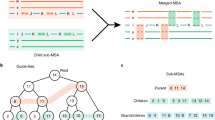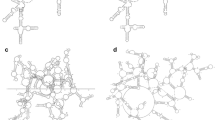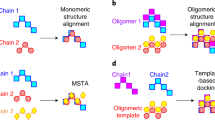Abstract
T-Coffee (Tree-based consistency objective function for alignment evaluation) is a versatile multiple sequence alignment (MSA) method suitable for aligning most types of biological sequences. The main strength of T-Coffee is its ability to combine third party aligners and to integrate structural (or homology) information when building MSAs. The series of protocols presented here show how the package can be used to multiply align proteins, RNA and DNA sequences. The protein section shows how users can select the most suitable T-Coffee mode for their data set. Detailed protocols include T-Coffee, the default mode, M-Coffee, a meta version able to combine several third party aligners into one, PSI (position-specific iterated)-Coffee, the homology extended mode suitable for remote homologs and Expresso, the structure-based multiple aligner. We then also show how the T-RMSD (tree based on root mean square deviation) option can be used to produce a functionally informative structure-based clustering. RNA alignment procedures are described for using R-Coffee, a mode able to use predicted RNA secondary structures when aligning RNA sequences. DNA alignments are illustrated with Pro-Coffee, a multiple aligner specific of promoter regions. We also present some of the many reformatting utilities bundled with T-Coffee. The package is an open-source freeware available from http://www.tcoffee.org/.
This is a preview of subscription content, access via your institution
Access options
Subscribe to this journal
Receive 12 print issues and online access
$259.00 per year
only $21.58 per issue
Buy this article
- Purchase on Springer Link
- Instant access to full article PDF
Prices may be subject to local taxes which are calculated during checkout




Similar content being viewed by others
References
Edgar, R.C. & Batzoglou, S. Multiple sequence alignment. Curr. Opin. Struct. Biol. 16, 368–373 (2006).
Kemena, C. & Notredame, C. Upcoming challenges for multiple sequence alignment methods in the high-throughput era. Bioinformatics 25, 2455–2465 (2009).
Notredame, C., Higgins, D.G. & Heringa, J. T-Coffee: a novel method for fast and accurate multiple sequence alignment. J. Mol. Biol. 302, 205–217 (2000).
Di Tommaso, P. et al. Cloud-Coffee: implementation of a parallel consistency-based multiple alignment algorithm in the T-Coffee package and its benchmarking on the Amazon Elastic-Cloud. Bioinformatics 26, 1903–1904 (2010).
Orbitg, M. et al. Exploiting parallelism on progressive alignment methods. J. Supercomputing 1, 1–9 (2009).
Wong, K.M., Suchard, M.A. & Huelsenbeck, J.P. Alignment uncertainty and genomic analysis. Science 319, 473–476 (2008).
Gribskov, M., Luethy, R. & Eisenberg, D. Profile analysis. Methods Enzymol. 183, 146–159 (1990).
Hunter, S. et al. InterPro: the integrative protein signature database. Nucleic Acids Res 37, D211–D215 (2009).
Gardner, P.P. et al. Rfam: updates to the RNA families database. Nucleic Acids Res. 37, D136–D140 (2009).
Wistrand, M. & Sonnhammer, E.L. Improved profile HMM performance by assessment of critical algorithmic features in SAM and HMMER. BMC Bioinformatics 6, 99 (2005).
Finn, R.D. et al. The Pfam protein families database. Nucleic Acids Res. 36, D281–D288 (2008).
Neumann, R. Publication Analysis 1997–2008- molecular genetics and genomics. Lab. Times 5, 47–48 (2010).
Henikoff, S. & Henikoff, J.G. Amino acid substitution matrices from protein blocks. Proc. Natl. Acad. Sci. 89, 10915–10919 (1992).
Just, W. Computational complexity of multiple sequence alignment with SP-score. J. Comput. Biol. 8, 615–623 (2001).
Larkin, M.A. et al. Clustal W and Clustal X version 2.0. Bioinformatics 23, 2947–2948 (2007).
Lassmann, T. & Sonnhammer, E.L. Kalign, Kalignvu and Mumsa: web servers for multiple sequence alignment. Nucleic Acids Res. 34, W596–W599 (2006).
Edgar, R.C. MUSCLE: multiple sequence alignment with high accuracy and high throughput. Nucleic Acids Res. 32, 1792–1797 (2004).
Katoh, K. & Toh, H. Recent developments in the MAFFT multiple sequence alignment program. Brief Bioinform. 9, 286–298 (2008).
Do, C.B. et al. ProbCons: probabilistic consistency-based multiple sequence alignment. Genome Res. 15, 330–340 (2005).
Pei, J., Kim, B.H. & Grishin, N.V. PROMALS3D: a tool for multiple protein sequence and structure alignments. Nucleic Acids Res. 36, 2295–2300 (2008).
Notredame, C., Holm, L. & Higgins, D.G. COFFEE: an objective function for multiple sequence alignments. Bioinformatics 14, 407–422 (1998).
Myers, E.W. & Miller, W. Optimal alignments in linear space. Comput. Applic. Biosci. 4, 11–17 (1988).
Thompson, J.D. et al. A comprehensive benchmark study of multiple sequence alignment methods: current challenges and future perspectives. PLoS One 6, e18093 (2011).
Wallace, I.M. et al. M-Coffee: combining multiple sequence alignment methods with T-Coffee. Nucleic Acids Res. 34, 1692–1699 (2006).
O'Sullivan, O. et al. 3DCoffee: combining protein sequences and structures within multiple sequence alignments. J. Mol. Biol. 340, 385–395 (2004).
Armougom, F. et al. Expresso: automatic incorporation of structural information in multiple sequence alignments using 3D-Coffee. Nucleic Acids Res. 34, W604–W608 (2006).
Orengo, C.A. & Taylor, W.R. SSAP: sequential structure alignment program for protein structure comparison. Methods Enzymol. 266, 617–635 (1996).
Soding, J. Protein homology detection by HMM-HMM comparison. Bioinformatics 21, 951–960 (2005).
Wilm, A., Higgins, D.G. & Notredame, C. R-Coffee: a method for multiple alignment of non-coding RNA. Nucleic Acids Res. 36, e52 (2008).
Thompson, J.D. et al. BAliBASE 3.0: latest developments of the multiple sequence alignment benchmark. Proteins 61, 127–136 (2005).
Notredame, C. & Abergel, C. Using multiple alignment methods to assess the quality of genomic data analysis. in Bioinformatics and Genomes: Current Perspectives (ed. Andrade, M.) 30–50 (Horizon Scientific Press, 2003).
Magis, C. et al. T-RMSD: a fine-grained, structure-based classification method and its application to the functional characterization of TNF receptors. J. Mol. Biol. 400, 605–617 (2010).
Jordan, G.E. & Piel, W.H. PhyloWidget: web-based visualizations for the tree of life. Bioinformatics 24, 1641–1642 (2008).
Kiryu, H., Kin, T. & Asai, K. Rfold: an exact algorithm for computing local base pairing probabilities. Bioinformatics 24, 367–373 (2008).
Bernhart, S.H. et al. RNAalifold: improved consensus structure prediction for RNA alignments. BMC Bioinformatics 9, 474 (2008).
Fernandez-Ballester, G. et al. Structure-based prediction of the Saccharomyces cerevisiae SH3-ligand interactions. J. Mol. Biol. 388, 902–916 (2009).
Abraham, M. et al. Analysis and classification of RNA tertiary structures. RNA 14, 2274–2289 (2008).
Schmidt, D. et al. Five-vertebrate ChIP-seq reveals the evolutionary dynamics of transcription factor binding. Science 328, 1036–1040.
Blanco, E. et al. Transcription factor map alignment of promoter regions. PLoS Comput. Biol 2, e49 (2006).
Felsenstein, J. PHYLIP: phylogeny inference package. Cladistics 5, 355–356 (1988).
Rose, P.W. et al. The RCSB Protein Data Bank: redesigned web site and web services. Nucleic Acids Res. 39, D392–D3401 (2011).
Camacho, C. et al. BLAST+: architecture and applications. BMC Bioinformatics 10, 421 (2009).
Acknowledgements
We thank J. Ramón González-Vallinas and E. Eyras for providing ChIP-seq analysis used in Figure 4. This project is supported by the Plan Nacional BFU2008-00419, the LEISHDRUG (no. 223414) and the Quantomics (KBBE-2A-222664) projects of the 7th Framework Programme of the European Commission and by a 'la Caixa' International PhD Program fellowship. Computational resources are provided by the Center for Genomic Regulation (CRG) of Barcelona.
AUTHOR CONTRIBUTIONS
J.-F.T., C.M., J.-M.C. and C.N. conceived and executed the experiments about protein sequences and structures. G.B., C.K. and C.N. conceived and executed the experiments about RNA sequences. I.E. and C.N. conceived and executed the experiments about DNA sequences. P.D.T. and C.N. conceived and developed the installation procedure. J.-F.T., C.M., G.B., J.-M.C., P.D.T., I.E., J.E.-C., C.K. and C.N. wrote the manuscript.
Author information
Authors and Affiliations
Corresponding author
Ethics declarations
Competing interests
The authors declare no competing financial interests.
Rights and permissions
About this article
Cite this article
Taly, JF., Magis, C., Bussotti, G. et al. Using the T-Coffee package to build multiple sequence alignments of protein, RNA, DNA sequences and 3D structures. Nat Protoc 6, 1669–1682 (2011). https://doi.org/10.1038/nprot.2011.393
Published:
Issue Date:
DOI: https://doi.org/10.1038/nprot.2011.393
This article is cited by
-
A review of alignment based similarity measures for web usage mining
Artificial Intelligence Review (2020)
-
Towards reconstructing the dipteran demise of an ancient essential gene: E3 ubiquitin ligase Murine double minute
Development Genes and Evolution (2020)
-
A revised biosynthetic pathway for the cofactor F420 in prokaryotes
Nature Communications (2019)
-
Crystal structure of a membrane-bound O-acyltransferase
Nature (2018)
-
A new aerobic chemolithoautotrophic arsenic oxidizing microorganism isolated from a high Andean watershed
Biodegradation (2018)
Comments
By submitting a comment you agree to abide by our Terms and Community Guidelines. If you find something abusive or that does not comply with our terms or guidelines please flag it as inappropriate.



